Weeds get a bad rap. Sure, many of them are often an invasive species. But according to Peter Michael Bauer, executive director of outdoor education nonprofit Rewild Portland, they're far from useless.
"There are so many weeds in people's yards they don't know are edible," he says. "That's part of the thing for me—educating people about the things in their yard they can eat and don't know and have demonized."
This Earth Day, the greater outdoors are basically off limits, but it's still possible to interact with the natural world right in your own neighborhood. Here, Bauer offers a quick primer on three weeds that are easy to find and don't require any further processing to consume.
Important note: Only forage in areas you know have not been sprayed with chemical herbicides—your own backyard, for example. It's not like you can travel far right now, anyway.

Dandelion
What can you do with it? The dandelion's bitter compounds assist the liver in producing more bile, which stimulates digestion and acts as a cleansing medicine. The roasted roots in the fall and winter make a delicious, stimulating, coffeelike tea.
What should you know? People don't know the difference between dandelion and catsear, and catsear doesn't taste very good. Catsear flowers later in the summer.

Chickweed
What can you do with it? It's a really succulent plant. It's really juicy and watery, so it goes good as topping on a salad, or even on pad thai in place of bean sprouts.
What should you be aware of? It has a few lookalikes that don't taste very good. The chickweed stem has a small little line of hairs, which is one way to tell it apart. Some of them have hair stems all around—those are not chickweed.

Lambsquarters
What can you do with it? Some people call it "wild spinach." You can stir fry it, add it to eggs in a scramble, anything like that.
What should you know? With spring greens, you want to get them early. Generally speaking, as the year goes on, those annuals are going to get woodier and woodier.
